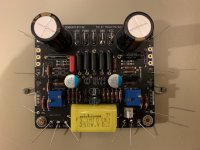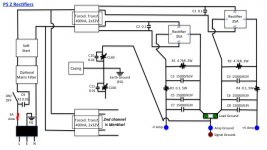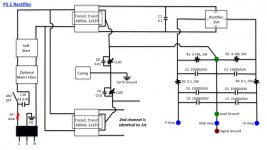Hi Fab,
Thanks for the QAP capacitor tip! They are priced right for film PP’s, I’ll have to give them a tryout 😉
Thanks for the QAP capacitor tip! They are priced right for film PP’s, I’ll have to give them a tryout 😉
Guys, I'm so sorry, but I can't find a thread about my question. But my last thread was deleted...
So... I got a question.
I want to buy or make diy eq pedal, but I know only GE-7 Equalizer (because I found it in my dad's garage). And it adds lots of noise.
I don't know much about guitar accessories, but I really want to. I need your help!
And if you want to know I got a Yamaha's guitar and amplifier. But I'm a newbie and don't know as much as I want.
So... I got a question.
I want to buy or make diy eq pedal, but I know only GE-7 Equalizer (because I found it in my dad's garage). And it adds lots of noise.
I don't know much about guitar accessories, but I really want to. I need your help!
And if you want to know I got a Yamaha's guitar and amplifier. But I'm a newbie and don't know as much as I want.
Hi Vunce
Be advised that this QAP takes a long time to break-in....however at the end it worths the while😉 ...at least for me.
Fab
Be advised that this QAP takes a long time to break-in....however at the end it worths the while😉 ...at least for me.
Fab
Attachments
Last edited:
Jack Ramirez
Please use this section instead :
https://www.diyaudio.com/forums/instruments-and-amps/
Fab
Please use this section instead :
https://www.diyaudio.com/forums/instruments-and-amps/
Fab
Jack Ramirez
Please use this section instead :
https://www.diyaudio.com/forums/instruments-and-amps/
Fab
Thnx
Ah, many thanks Fab!
You hinted to these in the manual, hence my insistance.
Any part you would recommend for those?
Back to the drawing board!
Claude
You hinted to these in the manual, hence my insistance.
Any part you would recommend for those?
Back to the drawing board!
Claude
Last edited:
Thanks to all helpers here this is the final schematic I came up with.
It is called "PS 2 Rectifiers" and uses 2 rectifiers (also called diode bridges, depending on where you live 🙂.
For those wanting to use only 1 rectifier I attached a second schematic, as alternative.
Although it all looks pretty straightforward and easy at the end, it isn't. There are quite a few subtilities and it took some time to decide what to keep and how to route. Consider these PS schematics do be definitive and I hope that posting these here will save others a lot of time and headache.
May that be of some use to anyone
Claude... defining part references, next headache will be dimensioning the heatsinks.
It is called "PS 2 Rectifiers" and uses 2 rectifiers (also called diode bridges, depending on where you live 🙂.
For those wanting to use only 1 rectifier I attached a second schematic, as alternative.
Although it all looks pretty straightforward and easy at the end, it isn't. There are quite a few subtilities and it took some time to decide what to keep and how to route. Consider these PS schematics do be definitive and I hope that posting these here will save others a lot of time and headache.
May that be of some use to anyone
Claude... defining part references, next headache will be dimensioning the heatsinks.
Attachments
normally if u use one.. across on off switch on u did itOK, that's what I come up with... lots of cleaning work.
No more bypasses around bridges etc., as that seems to be the practice nowadays, no more snubbers etc.
I have seen some fitting a 0.01uF cap in front of the primary of the transformer (or is it at mains between L & N for both transformers?): I wonder if you go for it... or not. Please let me know.
That's probably my last point re PS, so if you spot anything please shout, any help is greatly appreciated!
Many thanks
Claude
Also 0. 1 before diode. suggest use snubber instead
see quasimodo snubber. I find it helps alot. there is a list of known transformer and u can pluck the data from there.
Last edited:
Hi Vunce
Be advised that this QAP takes a long time to break-in....however at the end it worths the while😉 ...at least for me.
Fab
use a radio.. even better preamp at high gain without power on. lol. I do it all the time while amp is off duty
Looking into chassis now... Basicaly I either find a cheap donour (unlikely and possibly unworthy) or I find a nice one. Thinking HIFI2000.
I thought that their Dissipante line could be suitable, 4U to be on the safe side re radiators, 300mm depth enough. Am I in the right ball park? I plan to run at say 42-44V and would like as much bias as possible, at least 700mA.
Now sadly the HIFI2000 site is just horrible. There are so many confusing options that I better rely on people with real experience. As a starter:
- They charge a lot for the ali 3mm covers and rear pannel. Don't get why? Any advantage vs 1mm steel which seems to be std? Don't mind the extra as long as it makes sense for teh buid. Perhaps 1mm is too thin for a back pannel re stability? They don't seem to offer back pannels only options...
- On the contrary I found the thicker inner baseplate to be quite intersting given the mass of the trannies etc. Am I missing something? Better off reinforcing the existing base plate?
- Other things worthwhile considering or ordering from them for this build, while at it?
If someone with first hand experience with Dissipante chassis could enlighten me, on these points, please... 🙂
Many thanks
Claude
I thought that their Dissipante line could be suitable, 4U to be on the safe side re radiators, 300mm depth enough. Am I in the right ball park? I plan to run at say 42-44V and would like as much bias as possible, at least 700mA.
Now sadly the HIFI2000 site is just horrible. There are so many confusing options that I better rely on people with real experience. As a starter:
- They charge a lot for the ali 3mm covers and rear pannel. Don't get why? Any advantage vs 1mm steel which seems to be std? Don't mind the extra as long as it makes sense for teh buid. Perhaps 1mm is too thin for a back pannel re stability? They don't seem to offer back pannels only options...
- On the contrary I found the thicker inner baseplate to be quite intersting given the mass of the trannies etc. Am I missing something? Better off reinforcing the existing base plate?
- Other things worthwhile considering or ordering from them for this build, while at it?
If someone with first hand experience with Dissipante chassis could enlighten me, on these points, please... 🙂
Many thanks
Claude
Hello Claude,
Let me know what you find confusing and I'll be happy to help. Regarding your questions:
- The full aluminium version costs more simply because aluminium is more expensive than steel and requires more work and procedures.
Aluminium rear panel can only be mounted with steel covers so that is why we do not offer a "mixed" version
- If you plan to mount something heavy inside the inner baseplate is definitely required as it can substain up to 30 kg
Let me know what you find confusing and I'll be happy to help. Regarding your questions:
- The full aluminium version costs more simply because aluminium is more expensive than steel and requires more work and procedures.
Aluminium rear panel can only be mounted with steel covers so that is why we do not offer a "mixed" version
- If you plan to mount something heavy inside the inner baseplate is definitely required as it can substain up to 30 kg
Hi Gianluca
Thanks for your very kind reply in person!
Well, yes, confused as I don't know what to order and I lack some explanations on your website re options and pros and cons. The positive are you are responding in person... and I will have the lucky opportunity to train myself on power amp building on the VFET amp (so I just ordered a casing from you, hence me browsing on your site)
For this FSSA project, with 2 heavy trannies inside, what should I go for at the end / what are people considering usualy in terms of specs? I don't want a flimsy power amp, nor spending uneccessary money...
I understand thanks to your kind post that I need the baseplate, so that's a given. I guess it comes on top of the existing bottom plate, right? I hope it doesn't imped to much the available height inside the casing.
Now, let's look at the other option... should I go aluminium or steel? What are the differences / advantages?
And what about the important rear panel material. What do people go for regarding power amps, aluminium or steel? There will be binding posts for the LS, so it needs to be stable. I don't kow if a given thickness is also worth considering to enable parts to be nicely mounted, and if working steel is a pain vs aluminium?
Last but not least, IF I go for the cheaper steel version, does it come automaticaly with a 3mm aluminium rear panel as standard or is there an extra option I should tick (haven't seen it)?
Many thanks for your kind help
Claude
Thanks for your very kind reply in person!
Well, yes, confused as I don't know what to order and I lack some explanations on your website re options and pros and cons. The positive are you are responding in person... and I will have the lucky opportunity to train myself on power amp building on the VFET amp (so I just ordered a casing from you, hence me browsing on your site)
For this FSSA project, with 2 heavy trannies inside, what should I go for at the end / what are people considering usualy in terms of specs? I don't want a flimsy power amp, nor spending uneccessary money...
I understand thanks to your kind post that I need the baseplate, so that's a given. I guess it comes on top of the existing bottom plate, right? I hope it doesn't imped to much the available height inside the casing.
Now, let's look at the other option... should I go aluminium or steel? What are the differences / advantages?
And what about the important rear panel material. What do people go for regarding power amps, aluminium or steel? There will be binding posts for the LS, so it needs to be stable. I don't kow if a given thickness is also worth considering to enable parts to be nicely mounted, and if working steel is a pain vs aluminium?
Last but not least, IF I go for the cheaper steel version, does it come automaticaly with a 3mm aluminium rear panel as standard or is there an extra option I should tick (haven't seen it)?
Many thanks for your kind help
Claude
Hi Claude
Your heatsink size is more than enough and the selected voltage and bias should get only a warm feeling to the touch when ambient temperature is <25C. You may even increase the bias if you tolerate a warmer heatsink temperature (but lower than 55C). Ensure you install the recommended thermal switch to power off the amp upon a too high temperature.
Fab
Your heatsink size is more than enough and the selected voltage and bias should get only a warm feeling to the touch when ambient temperature is <25C. You may even increase the bias if you tolerate a warmer heatsink temperature (but lower than 55C). Ensure you install the recommended thermal switch to power off the amp upon a too high temperature.
Fab
Many thanks Fab!
Yep, my intension is to be able to crank up bias as much as I can while keeping long time reliability even under hot climates (you never know...), hence going 4U instead of 3U (which could possibly make the trick, but then...)
Take care
Claude
Yep, my intension is to be able to crank up bias as much as I can while keeping long time reliability even under hot climates (you never know...), hence going 4U instead of 3U (which could possibly make the trick, but then...)
Take care
Claude
If you plan to install an inner pierced base the useful inner height will be reduced of about 5mm. This is usually mounted on top of the bottom panel but it does not cover its whole surface.
The steel rear panel is actually more robust because it comes with 2 small bendins on the top and the bottom edge. It is made of 1mm thick steel VS 3mm thick aluminium.
The main thing with the aluminium rear panel is that it can bend a bit if you plan to mount a lot of connectors on it but it's a lot easier to work on.
If you buy the steel chassis, both the covers and rear panel are going to be made of steel. If you want an aluminium rear panel you would need to buy the model with aluminium covers as well.
The steel rear panel is actually more robust because it comes with 2 small bendins on the top and the bottom edge. It is made of 1mm thick steel VS 3mm thick aluminium.
The main thing with the aluminium rear panel is that it can bend a bit if you plan to mount a lot of connectors on it but it's a lot easier to work on.
If you buy the steel chassis, both the covers and rear panel are going to be made of steel. If you want an aluminium rear panel you would need to buy the model with aluminium covers as well.
Nope, crazy workload and "building" my new house... so ashamed about it, wanted to do it in the summer. But I will have to have it finished before mid next year for my new place, need though to finish the pre first as can't really use it otherwise! On it now, assembling and casing are so long!
I have though purchased all the sensitive parts for FSSA (except the common ones on the board as Fab might be progressing on that... while I am very slow). I received the casing and received all the (very) big PS caps. Next on line are assembling the casing to make a dry fit and making sure the transformers fit... before I order them as they are quite costly.
That project needs really to get started, but being my first amp project since... over 20y, I thought wiser to finish first a beginner' amp project to get me started again: the VFET amp for a secondary system... and it is probably finished since last week. So albeit very slow, I do actually progress on HIFI LOL
Sorry again...Any question just ask
Claude
I have though purchased all the sensitive parts for FSSA (except the common ones on the board as Fab might be progressing on that... while I am very slow). I received the casing and received all the (very) big PS caps. Next on line are assembling the casing to make a dry fit and making sure the transformers fit... before I order them as they are quite costly.
That project needs really to get started, but being my first amp project since... over 20y, I thought wiser to finish first a beginner' amp project to get me started again: the VFET amp for a secondary system... and it is probably finished since last week. So albeit very slow, I do actually progress on HIFI LOL
Sorry again...Any question just ask
Claude
ClaudeG,
Good luck with getting the house ready! And share some pics once it's done. 🙂
These projects do take time... I am also sitting on a bunch of parts, while waiting for a few more to come.
Good to know that you are enjoying the VFET amp - it's about enjoying the music too, right? 🙂
Hope other folks also chime in with updates.
Good luck with getting the house ready! And share some pics once it's done. 🙂
These projects do take time... I am also sitting on a bunch of parts, while waiting for a few more to come.
Good to know that you are enjoying the VFET amp - it's about enjoying the music too, right? 🙂
Hope other folks also chime in with updates.
- Home
- Amplifiers
- Solid State
- FSSA amplifier build thread with review


